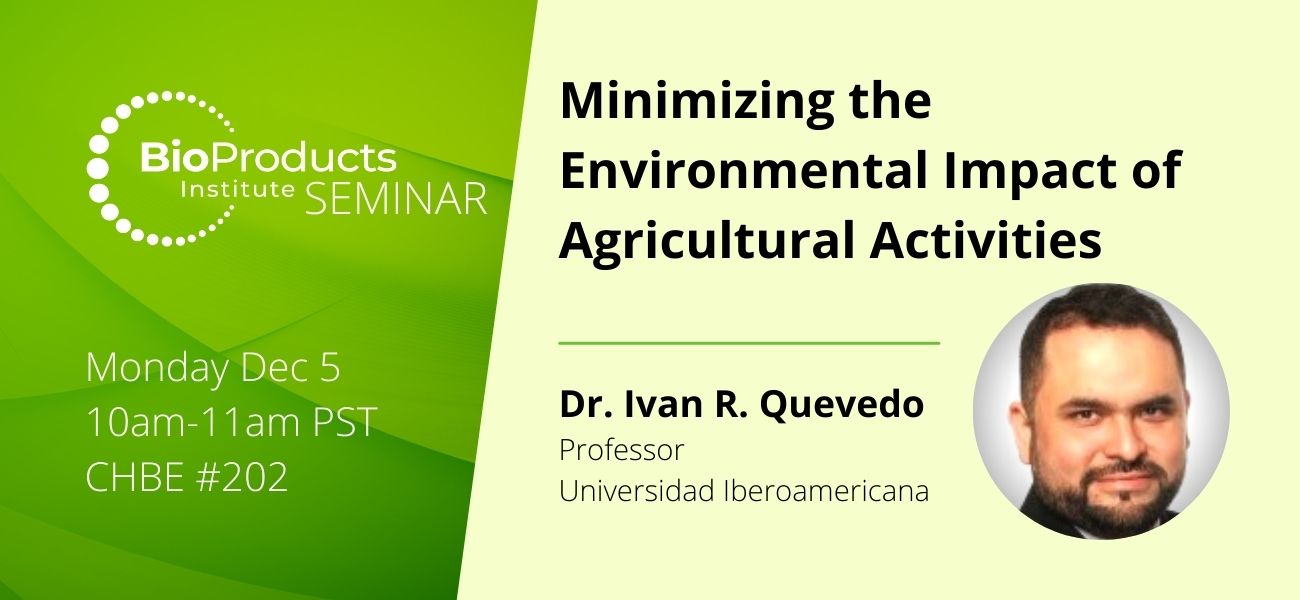BPI Seminar By Dr. Ivan Quevedo
December 5, 2022, 10:00 am to 11:00 am
TITLE
Minimizing the Environmental Impact of Agricultural Activities
ABSTRACT
According to the Food and Agriculture Organization (FAO), food and agriculture production systems are facing unprecedented challenges (i.e., an increasing food demand for a growing population, rising hunger and malnutrition, adverse climate change effects, overexploitation of natural resources, loss of biodiversity, and food loss and waste) undermining the world’s capacity to meet present and future needs. Agricultural activities contribute to a number larger of environmental issues that cause environmental degradation and we are interested in gaining an in-depth understanding of two aspects:
- Development of Innovative Controlled-Release Agrochemicals. Up to 50% of the agrochemicals applied to the soil are lost due to the consequent processes of leaching and/or evaporation, causing environmental pollution. In anticipation of the increase in population, the search for agroecological alternatives is still on the radar of the industry. A sustainable and innovative proposal consists of using organic residues (e.g., derived from invasive algae or food waste), to obtain biopolymers (e.g., structural polysaccharides and sugars) with the potential to be used as encapsulating material for agrochemical compounds. Our research is focused on finding biodegradable materials that will be of great benefit to society because they will allow the generation of sustainable methodologies for the use and recovery of organic waste, and result in different agroecological alternatives.
- Protecting Groundwater Aquifers from Agricultural Pollution. A number of agricultural practices (i.e., addition of pesticides, fertilizers, and animal waste) can contribute to groundwater pollution. The use of manure and biosolids and their application to agricultural land is a common strategy to enhance the nutrient levels in the soil, but it might also result in biological contamination of groundwater through surface runoff. Same applies in developing countries where wastewater is commonly used to irrigate crops coming from sources with poor quality, and where the lack of adequate wastewater treatment processes in the water used for irrigation of crops and replenishment of groundwaters has resulted in outbreaks of gastrointestinal diseases. In our research group, we aim to achieve a better understanding of the fundamental principal to prevent pathogen mobility in surface and subsurface water is required to prevent polluting groundwater reserves.

AGENDA
- Introduction by Dr. Emily Cranston
- Keynote Presentation by Dr. Ivan Quevedo, IBERO
- Q&A / Discussion
ABOUT THE SPEAKER
Member of the National System of Researchers for CONACyT, Mexico (Level 1) since 2016. Areas of academic research interest include: i) transport and fate of emerging contaminants; and ii) development of novel biomaterials with applications in Agriculture. Dr. Quevedo is currently a visiting professor at Prof. Emily Cranston´s research group at UBC and a full-time faculty in the Department of Industrial and Food Chemical Engineering at Universidad Iberoamericana in Mexico City. Dr. Quevedo received his PhD in Chemical Engineering from McGill University, where he was awarded a McGill Engineering Doctoral Award (MEDA) and then became a Postdoctoral ORISE fellow at the U.S. Food and Drug Administration (FDA).
REGISTRATION FOR SEMINAR BY DR. QUEVEDO
Please fill out the below form to register for the event.
